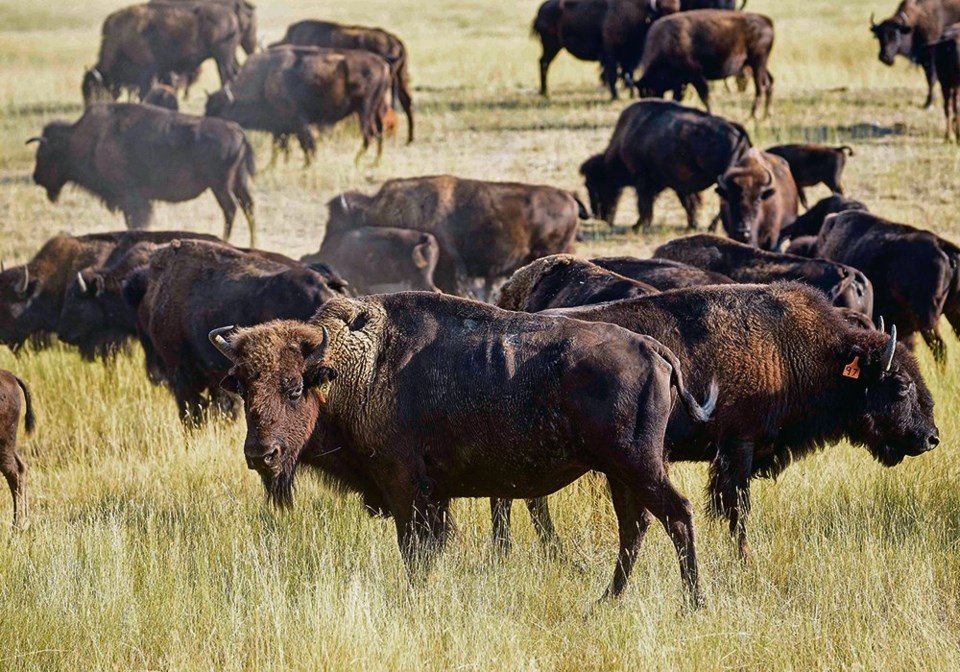WESTERN PRODUCER — According to , all bison in North America carry multiple small, yet identifiable regions of DNA that originally came from cattle.
The research confirms there are, in fact, no purebred bison on the continent.
“I did genetic bison research 20 years ago and, at that time, it was cutting edge,” said James Derr, director of the DNA Technologies Core Laboratory at the university’s Departmentt of Veterinary Pathobiology.
“We looked for evidence of introgression of cattle genes in bison and we found it in most places such as cattle mitochondrial DNA from the mother or markers in the nuclear genome that distinguished cattle from bison.
“(Back then) we found cattle genetics in a lot of bison herds but not in those in Yellowstone, Wind Cave, Elk Island or Wood Buffalo national parks. Since then, we have gone through another generation of advancing technology. The technology today is for whole genome sequencing. That means there is no place in the genome where anything can hide. We can look at every single gene in a bison and determine whether a gene or a DNA sequence came from bison or cattle.”
When European settlers arrived in North America, an estimated 40 million bison roamed the prairies and high plains. But populations were decimated by overhunting and expansion of settlement to the point where, by the mid-1880s, their numbers were down to a perilous few hundred in just six herds. But even as those animals were under threat of extinction, efforts by conservationists and sportsmen to save the species were underway.
In 1905, the American Bison Society was formed with William Hornaday, first director of the New York Zoological Park, as president. In 1907, ABS shipped 15 bison (six bulls and nine cows) from the zoo to the Wichita Mountains Wildlife Refuge in Oklahoma. The organization continued to secure populations of bison in public herds until it was disbanded in 1935 and then relaunched in 2005 by the Wildlife Conservation Society.
In 1907, the Canadian government bought the Pablo-Allard herd in Montana and, between 1907 and 1912, 700 bison were shipped by rail to Elk Island National Park.
Ranches were spreading and ranchers raised bison as livestock, breeding them with their cattle. It was that management practice among private herds that led to cattle introgression in bison. While the crossbreeding practice was successful, the objective to produce a better beef-producing animal failed and the practice was discontinued. Yet that genetic legacy persists today as evidenced in Derr’s current study.
“Two primary events 小蓝视频 an extremely small bison population size and widespread interest in developing hybrid animals changed and shaped the genomes of this species in ways we are just now starting to understand,” he said.
Derr’s team conducted various tests and sampling strategies. One included bison that represented all the historical founder bison lineages established in the late 1800s. Hair, blood, hide, tissue, and bone samples from historical and modern bison from across North America were collected from museum holdings and bison populations. Hide and bone came from curated collections while hair and blood came from annual roundups co-ordinated by ranches.
In addition, samples for DNA analysis were taken from four cattle breeds — Angus, Hereford, Charolais, and Holstein. These breeds were chosen because they were known to be used in past bison-cattle hybridization programs.
A further test compared genome sequences among the major historical lineages of bison to a panel of 1,842 domestic cattle genomes representing all major breeds. The tests confirmed that all analyzed bison genomes contained evidence of cattle introgression.
“Virtually in every bison we sequenced, we found multiple regions of cattle genes,” said Derr. “I would never say never (that there are purebred bison) because technology always changes, but at this point, I don’t think we can put the genie back in the bottle. My personal opinion is that I don’t think there’s a bison out there that doesn’t have some cattle introgression.”
According to a media release, the Canadian Bison Association, which provided some of the research funding, welcomed the research.
“With this information we can continue to lead the way to grow healthy populations of this iconic animal,” said president Les Kroeger.
Bison are valued as a cultural keystone species, holding religious and spiritual roles. As a wildlife species of continental pride, bison were named the United States national mammal in 2016. As a livestock animal, they are raised for meat and fibre.
Turner Enterprises in Bozeman, Montana, is the largest private producer with more than 45,000 bison. A goal of the organization is to apply Derr’s genetic work in the management of maternal herds.
“Knowing that the North American bison herd has widespread introgression of cattle DNA, though in small amounts, will allow our operations to structure future genetic management between our herds to maintain broad genetic diversity without the worry of cross contaminating herds that were perceived to be clean of introgression,” Mark Kossler, vice-president of Turner Enterprises’ ranch operations, said in the news release.
Derr now plans to focus the research on critical bison diseases.
“What I am passionate about for the future of bison genomics is to investigate bison genes that are important for their immune response to disease,” he said.
“There are several diseases that are absolutely devastating in bison, and I want to know why, genetically, bison seem particularly susceptible to infectious diseases such as mycoplasma that causes pneumonia, the bacterial diseases brucellosis and tuberculosis, and a virus that causes malignant catarrhal fever (MCF).
“In fact, cattle can get MCF, and they may certainly get sick, but bison seem to be extremely susceptible to this disease and it is often highly fatal when it breaks out in a bison herd.”
The research paper was published in the journal Scientific Reports.





